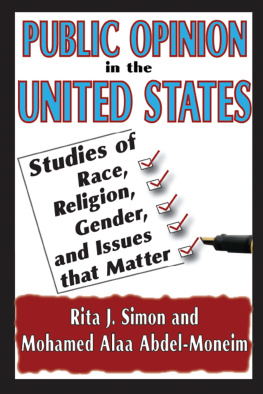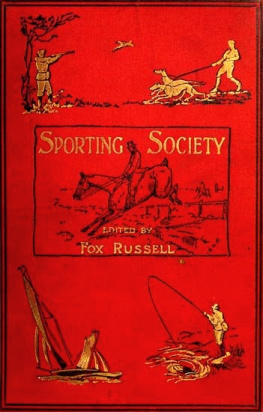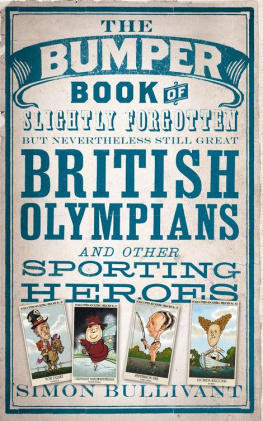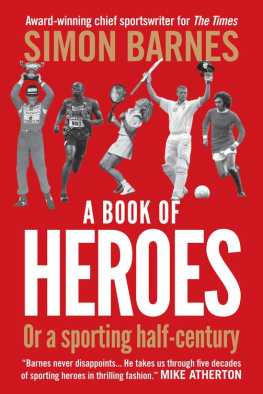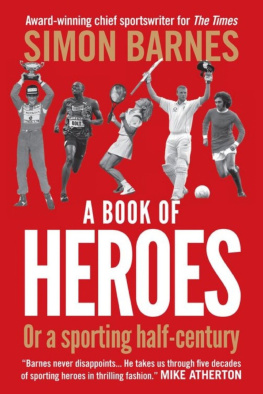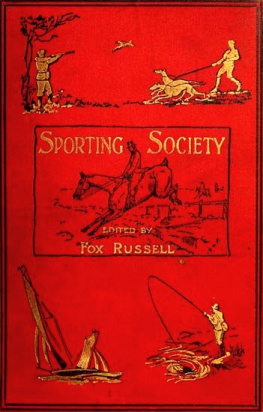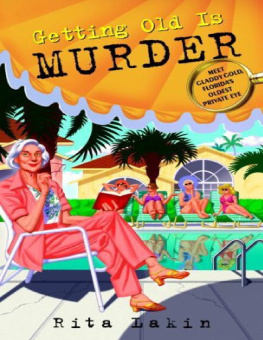Sporting
Equality
Title IX Thirty Years Later
Sporting
Equality
Rita J. Simon, editor
First published 2002 by Transaction Publishers
Published 2017 by Routledge
2 Park Square, Milton Park, Abingdon, Oxon OX14 4RN
711 Third Avenue, New York, NY 10017, USA
Routledge is an imprint of the Taylor & Francis Group, an informa business
New material copyright 2005 by Taylor & Francis Parts of this volume were previously published in Gender Issues, Spring/ Summer 2002, Vol. 20, Nos. 2/3, copyright 2002 by Taylor & Francis..
All rights reserved. No part of this book may be reprinted or reproduced or utilised in any form or by any electronic, mechanical, or other means, now known or hereafter invented, including photocopying and recording, or in any information storage or retrieval system, without permission in writing from the publishers.
Notice:
Product or corporate names may be trademarks or registered trademarks, and are used only for identification and explanation without intent to infringe.
Library of Congress Catalog Number: 2004051694
Library of Congress Cataloging-in-Publication Data
Sporting equality : Title IX thirty years later / Rita J. Simon, editor.
p. cm.
Parts of this volume were previously published in Gender issues, spring/summer 2002, vol. 20, nos. 2/3T.p. verso.
Includes bibliographical references.
ISBN 0-7658-0848-X (pbk.)
1. Sports for womenUnited States. 2. Women athletesGovernment policyUnited States. 3. Sex discrimination in sportsUnited States. 4. United States. Education Amendments of 1972. Title IX I. Simon, Rita James.
GV709.18.U6S67 2005
796.082dc22
2004051694
ISBN 13: 978-0-7658-0848-6(pbk)
Contents
Rita J. Simon
Secretarys Commission on Opportunities in Athletics
Secretarys Commission on Opportunities in Athletics
Donna de Varona and Julie Foudy
Katherine Kersten
Andrew Zimbalist
Lisa Keegan
Kimberly A. Yuracko
Earl C. Dudley, Jr. and George Rutherglen
Barbara Murray
John J. Cheslock and Deborah J. Anderson
Leo Kocher
Ellen J. Staurowsky
Sporting Equality: Title IX Thirty Years Later includes the major findings and recommendations of the Secretary of Educations Commission on Opportunities in Athletics established on June 27, 2002, as well as the Commissions Minority Report authored by Julie Foudy, captain of the U.S. Womens National Soccer Team and Donna de Varona, first president of the Womens Sports Foundation and Olympic gold medallist. Secretary of Education Rod Paige, to whom both reports were submitted, stated he would not accept the recommendations in the Minority Report and would accept only the fifteen of the twenty-three recommendations in the Majority Report that were adopted unanimously.
In addition, the collection includes articles by a member of the Commission, Lisa Keegan, chief executive officer of the Education Leaders Council, and edited versions of the testimony provided by Katherine Kersten, a senior fellow for cultural studies at the Center of the American Experiment, at the Commissions Chicago Town Hall meeting, and Andrew Zimbalist, who is the Robert A. Woods Professor of Economics at Smith College, at the Commissions San Diego Town Hall Meeting.
These pieces are followed by six chapters that analyze and assess the strength and weakness of Title IX, and offer recommendations for strengthening or changing the goals and objectives of Title IX.
Two of the chapters are by law professor Kimberly A. Yuracko, assistant professor of law, Northwestern University School of Law, Title IX and the Problem of Gender Equality in Athletics and Earl C. Dudley, Jr. and George Rutherglen, professors of law at the University of Virginia Law School, A Comment on the Report of the Commission to Review Title IX Enforcement in Athletics. Barbara Murray, a graduate student in education at the University of Pennsylvania, prepared a research plan on How to Evaluate the Implementation of Title IX at Colleges and Universities and Attitudes and Interest of Students Regarding Athletics.
Professors of education John J. Cheslock and Deborah J. Anderson, both at the University of Arizona, contribute a chapter, Lessons from Research on Title IX and Intercollegiate Athletics, that discusses how empirical research can inform the debate over Title IX given the policy environment that focuses on substantial proportionality.
The two most controversial chapters in the volume are by Leo Kocher, head wrestling coach of the University of Chicago, who claims that the manner in which Title IX has been interpreted clearly and unequivocally discriminates against male athletes, especially those in minor sports such as gymnastics, swimming, wrestling, and track; and Ellen J. Staurowsky, professor in the Department of Sport Management and Media at Ithaca College, who writes with the same stridency and sense of conviction that Title IX has not gone far enough nor has it been aggressively enforced enough to provide women athletes with the equality they deserve.
Rita J. Simon
Secretarys Commission on Opportunities in Athletics
Without a doubt, Title IX has opened the doors of opportunity for generations of women and girls to compete, to achieve, and to pursue their American dreams. This Administration is committed to building on those successes.U.S. Secretary of Education Rod Paige, June 2002
On June 27, 2002, U.S. Secretary of Education Rod Paige established the Secretarys Commission on Opportunities in Athleticsthe first federal advisory panel created to study Title IX. The purpose of the 15-member Commission was to collect information, analyze issues, and obtain broad public input directed at improving the application of current federal standards for measuring equal opportunity for men and women and boys and girls to participate in athletics under Title IX.
Passed by Congress as part of the Education Amendments of 1972, Title IX provides that [N]o person in the United States shall, on the basis of sex, be excluded from participation in, be denied the benefits of, or be subjected to discrimination under any education program or activity receiving federal financial assistance.
As noted in the Commissions charter, prior to the enactment of Title IX many schools and post-secondary institutions were free to discriminate against women and girls. However, over the past three decades many new doors of opportunity have been opened for women and girls. In 1972, when Title IX was enacted, 44 percent of all bachelors degrees were earned by women, as compared to 57 percent in 2000. During the same period, the percentage of women earning medical degrees increased from 9 to 43 percent. Title IX (along with changes in the view of what roles girls and women should play in society) has also had a marked impact on the athletics programs offered by educational institutions across the country. The number of womens and girls athletic teams at both the high school and college levels has dramatically increased. From 1981 to 1999, the total number of college womens teams increased by 66 percent. The growth of certain womens sports has been explosive during this period. According to the General Accounting Office, for example, colleges created over 846 new womens soccer teams. In 1971, 294,015 girls participated in high school athletics. Today, over 2.7 million girls participate in high school athletics. This represents an 847 percent increase. It is clear, though, that more still needs to be done to ensure that girls and women are not discriminated against and that we continue to expand the array of athletic opportunities available to men, women, boys and girls. As further noted in the Commissions charter, despite the gains in athletic programs for women and girls, issues have been raised about the effectiveness of the federal governments Title IX enforcement. The questions generally fall in two areas:





